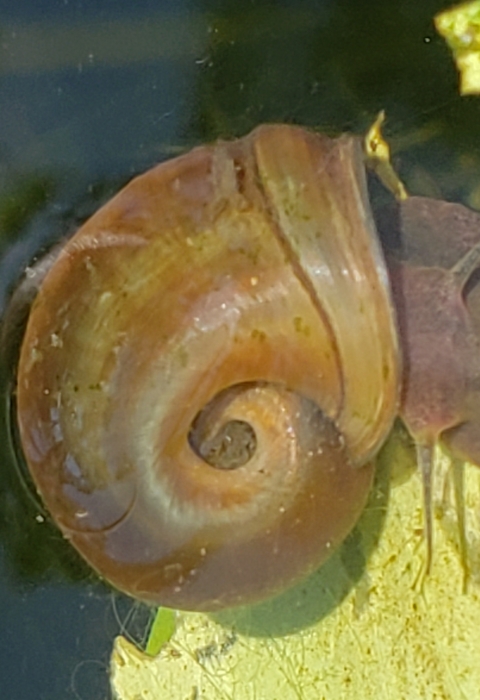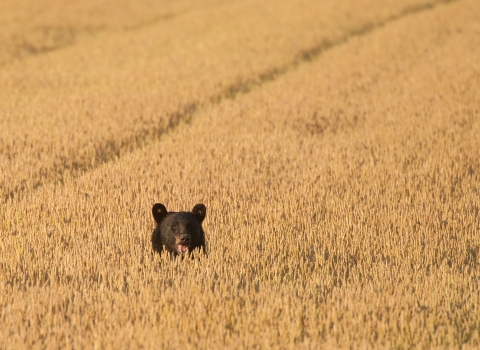What is a magnificent ramshorn snail?
The magnificent ramshorn is a species of air-breathing snail endemic to southeastern North Carolina. It is a freshwater snail in the family Planorbidae (Pilsbry 1903) and is the largest North American snail in this family. Its relatively thin shell has a discoidal shape (i.e., coiling in one plane) that reaches approximately 1.5 inches in diameter. The aperture of the shell is somewhat bell-shaped and very wide, extending beyond the sides of the shell. Like other members of the Planorbidae family, the magnificent ramshorn is primarily herbivorous, feeding on submerged aquatic plants, algae, and detritus (decomposing plant material).
What is the Service proposing for the magnificent ramshorn snail?
Following a review of the best available science, the U.S. Fish and Wildlife Service is proposing to list the magnificent ramshorn snail as an endangered species under the Endangered Species Act (ESA). The magnificent ramshorn is an air-breathing snail, historically documented from only four sites in the lower Cape Fear River Basin in southeastern North Carolina. Experts surveyed over 100 potential sites (including most historical locations) over the last few decades and have not found any magnificent ramshorn snails. The species is currently believed to be extirpated in the wild. Efforts are currently underway to maintain the species alive in captivity and to propagate it for future releases into the wild.
The Service is also proposing to designate 739 acres of ponds as critical habitat for the magnificent ramshorn in Brunswick County, North Carolina, where the magnificent ramshorn snails could be released to repopulate their historical habitat.
Why is the magnificent ramshorn snail in danger of extinction?
While several factors have likely contributed to the extirpation of the magnificent ramshorn in the wild, the primary factors include loss of pond and standing water habitats associated with the extirpation of beavers and their impoundments in the early 20th century. Increased salinity and alteration of flow patterns in the lower Cape Fear River Basin, as well as increased input of nutrients and other pollutants, also have contributed to the snail's decline. These ongoing stressors, coupled with extreme weather events from ongoing and future climate change climate change
Climate change includes both global warming driven by human-induced emissions of greenhouse gases and the resulting large-scale shifts in weather patterns. Though there have been previous periods of climatic change, since the mid-20th century humans have had an unprecedented impact on Earth's climate system and caused change on a global scale.
Learn more about climate change , could continue to impact the breeding, feeding, sheltering, and dispersal needs of the snails.
How many magnificent ramshorns remain in the wild?
None. Repeated surveys in suitable habitat within the known historical range have yielded no observations of the magnificent ramshorn in the past 40 years. Based on the results of these surveys, we have determined that the species may no longer exist in the wild. While likely extirpated from the wild, it does persist in captive populations.
Where did the captive snails come from?
All the magnificent ramshorn snails currently in captivity are descendants of adult snails from two distinct populations from Pleasant Oaks Pond and Orton Pond in Brunswick County, North Carolina.
Captive holding of the magnificent ramshorn began in the early 1990s, when individuals were collected to learn about their life history requirements (Adams 1993). In the mid-1990s, snails were held in captivity at the NC Aquarium at Fort Fisher, but they were later moved to a private residence due to the influence of salt-laden air at the aquarium. This population has been in a well-maintained snail sanctuary at the private residence since then.
In early 2012, a captive population was established at NC State University’s at the former College of Veterinary Medicine’s (CVM) Aquatic Epidemiology Conservation Laboratory in Raleigh, North Carolina. The program is currently under NC State’s Department of Marine, Earth and Atmospheric Sciences. A third captive population is being held at the North Carolina Wildlife Resources Commission’s (NCWRC) Conservation Aquaculture Center in Marion, NC.
How will federal protection help?
Conservation measures provided to species listed as endangered or threatened species under the ESA include recognition, recovery actions, requirements for Federal protection, and prohibitions against certain practices. Recognition through listing results in public awareness, and conservation by Federal, State, and local agencies, private organizations, and individuals. The ESA encourages cooperation with the States and other countries and calls for recovery actions to be carried out for listed species.
Designating critical habitat as proposed, would help conserve two ponds in Brunswick County, North Carolina, that have potential for the magnificent ramshorn to reoccupy and prosper in the wild. Reestablishing viable populations in those ponds will provide redundancy within the historical range and establish the species’ ecological representation.
What actions are underway to help the species avoid extinction?
The NC Division of Water Resources and the Service are working with the city of Wilmington, North Carolina, to improve the water quality of Greenfield Lake which formerly supported the species. Greenfield Lake is currently on the state’s list of impaired water bodies.
In 2018, Service staff performed an analysis to determine the suitability of potential habitats within the former range to support introduction of magnificent ramshorn snails. The results of the analysis are being used by field staff to verify suitability of potential locations. In preparation for potential introduction, the Service has drafted experimental protocols to detail necessary steps for possible introduction of the species into the wild. Further, the Service is interested in working with private landowners to contribute to the conservation of the species.
In 2019 and 2020, Service staff met with Department of Defense (DoD) and the NC Plant Conservation Program (PCP), both landowners with several ponds on their properties within the historical range of the magnificent ramshorn. The DoD’s Military Ocean Terminal Sunny Point is immediately adjacent to the private property last known to have the species in the wild. The PCP owns ponds in the same watershed as the historical locations. Both are amenable to having water quality analyses to determine whether their ponds could be suitable habitat for snail introduction, and that habitat assessment work began in 2021 under the lead of the NCWRC.
A 2019 legal settlement between NCDOT and plaintiffs for the Complete 540 transportation project includes $250,000 for magnificent ramshorn propagation. The road project is not expected to impact the magnificent ramshorn, but funds were appropriated for the species pursuant to the agreement. This funding source secures support for propagation to the future while we work on site assessments and landowner support for reintroduction.
If the magnificent ramshorn snail is listed as endangered, what happens next?
Once a species receives federal protection, the Service will develop and implement a recovery plan for the conservation of the species. The recovery planning process involves the identification of actions that are necessary to halt or reverse the species’ decline by addressing the threats to its survival and recovery. The goal of this process is to restore listed species to a point where they are secure, self-sustaining, and functioning components of their ecosystems.
Recovery planning consists of preparing draft and final recovery plans, beginning with the development of a recovery outline and making it available to the public within 30 days of a final listing determination. The recovery outline guides the immediate implementation of urgent recovery actions and describes the process to be used to develop a recovery plan.
If this species is listed, funding for recovery actions will be available from a variety of sources, including Federal budgets, State programs, and cost-share grants for non-Federal landowners, the academic community, and nongovernmental organizations. In addition, pursuant to section 6 of the ESA, the State of North Carolina would be eligible for Federal funds to implement management actions that promote the protection or recovery of the magnificent ramshorn. Information on our grant programs that are available to aid species recovery can be found at: http://www.fws.gov/grants



